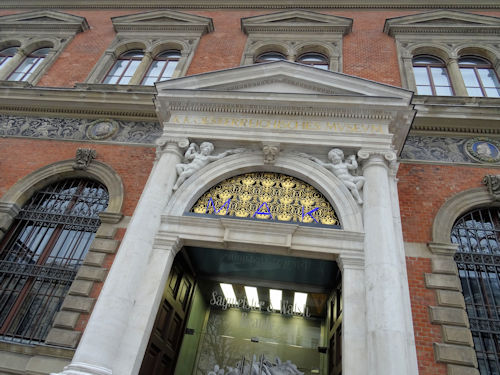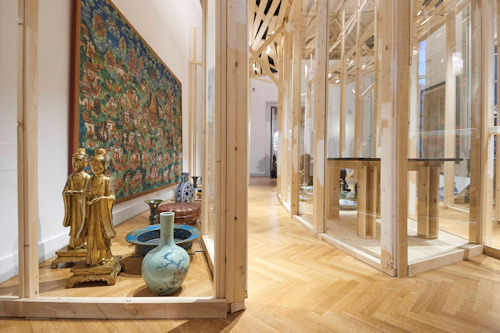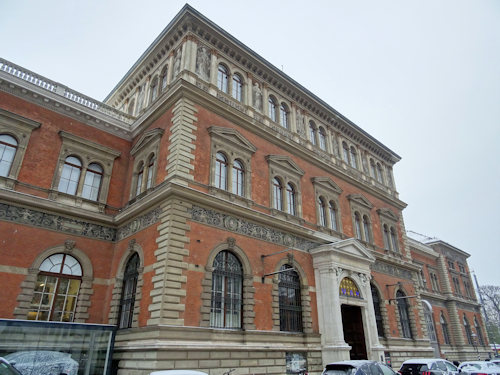When you visit places for a living, apathy can set in. Another priceless Habsburg artifact? Yawn. The MAK, however, leaves me feeling young and invigorated again, offering a particular delight among the museal treats in Vienna.
- The history, present & future of applied arts
- Everything from Baroque glassware to industrial design
- Numerous special (contemporary) art and/or design exhibitions
- Look up for lovely neo-renaissance ceilings
- Book MAK tickets* online
- Selected special exhibitions:
- HARD/SOFT ceramics & textiles (until May 20, 2024)
- Iconic Auböck (May 15th to October 13th, 2024)
- See also:
- Other design exhibitions
- Selected past MAK exhibition reviews
What’s the MAK?

(The front entrance to the museum)
It’s hard to come up with a glib description of what the MAK is all about.
Consider it a design museum. Or an art museum. But also a history museum. And one of the few museums that makes you really think about the places we inhabit and the items we use at home and work.
Also, they do one or two things a little differently there. Things that elicit a “goodness, that’s cool” from me (bear in mind I’m over 50, though).
The museum traces its roots back to 1864 and the opening of the Imperial Royal Museum of Art and Industry, intended as Austria’s equivalent to what is now the Victoria and Albert Museum in London.
Today’s modern successor – the MAK – focuses on applied arts in the context of different eras, materials, and disciplines.
The museum’s contents reflect this remit, being split into three main physical and/or topical areas:
- The permanent collections and exhibitions
- The design lab
- The special exhibitions
The MAK is also its own work of art. Heinrich von Ferstel designed the museum building, which opened in 1871. (He also designed the main University of Vienna building, the Votivkirche, and Palais Ferstel.)
Just beyond the entrance, for example, is a beautiful pillared atrium that you could just gaze at for a while and feel you already got your money’s worth. Gorgeous neo-renaissance designs and motifs cover the ceilings. So just lie back and think of…Italy.
And, if you visit after dusk, the MAKlite installation lights up the windows when viewed from the outside in a sequence of bright colours.
Incidentally, the MAK actually manages several locations around the world, though the main building is the one of particular interest for visitors to Vienna.
The permanent displays

(Part of the MAK’s Asian exhibition; press photo © MAK/Georg Mayer)
Wonderfully, every permanent exhibition area has a different layout and display concept. This gives each section its own unique and appropriate context and avoids the ennui that a never-ending sequence of identical display cases sometimes induces.
The MAK’s Asia rooms illustrate this creative approach perfectly. Wooden scaffolding and glass combine to form giant display cabinets, with item descriptions written directly on the glass or walls.
The history element of the museum comes to the fore in the permanent displays, tracing design through the recent centuries and showcasing various highlights from the MAK’s archives and collections.
Glass, tableware, lace and furniture dominate in rooms devoted to Baroque Rococo Classicism, the Biedermeier period, Historicism Art Nouveau, and Renaissance Baroque Rococo.
(As a novelist, the glorious antique writing desks induced a fair degree of envy.)
One of the MAK’s other sites also has displays of Biedermeier and Empire furniture and fittings: the Geymüllerschlössel villa in Vienna’s 18th district.
Chairs are a big theme. They dominate, for example, the Historicism Art Nouveau room, a concept much enlivened by the screens running down the centre of the hall (so you see a beautiful strip of silhouettes).
The MAK is also one place you can view the world-famous steam-bent wooden chair Model No. 14, designed by Thonet in 1859 and sold in its millions.

(The wider museum façade)
The Vienna 1900 display covers that period of artistic endeavour that stretches from the late 19th century to just before the arrival of the Nazis, with a notable focus on furniture and tableware.
This is the time of Klimt, Wagner, Hoffman, Loos, Prutscher, Moser, Strnad, Olbrich, and others from an era that includes Viennese Modernism, Jugendstil, the Wiener Werkstätte, and Secessionism.
The design lab
The Design Lab rooms explore the interface between art, design, and industry. They trace patterns of development, address the conflict between the needs of society and those of the individual, and offer a strong focus on environmental and futuristic issues.
So you’ll find a dynamic, eclectic mix that might vary from a reconstruction of the Frankfurt kitchen that was the precursor of today’s fitted kitchens through to a 3d-printed handgun.
All-in-all, the MAK feels like you stumbled into the secret mansion of some immortal collector, who spent the last couple of centuries travelling the globe to accumulate items from across design genres for his unfeasibly large drawing room.
Temporary special exhibitions
At any one time, several temporary exhibitions and installations provide some remarkable treats. Find full listings on the exhibitions page.
These have a more contemporary flavour, often featuring the work of living artists and tackling issues of particular relevance to today’s world.
Tickets & visitor tips
Any valid entrance ticket from or for the MAK includes the special exhibitions, too.
(Booking service provided by Tiqets.com*, who I am an affiliate of)
Some tips:
- You can visit both the shop and the coffee house / restaurant without actually going into the museum proper (or paying for a ticket).
- The shop was packed with books and (no surprise) neat little design objects
- The restaurant is not your standard museum cafe, but a full-blown, rather stylish, gourmet eatery. So not a quick snack type of place, though the coffee prices were fairly normal on my visit
(The coffee house opposite – Café Prückel – is one of Vienna’s revered traditional establishments. I often have summer breakfasts there in the outdoor section.)
- Many information displays are in English, and you can borrow free guidebooks which provide English descriptions of items in the permanent collections
- Get in once for free if you have a Vienna Pass sightseeing card (see my review)
- Look left as you leave the MAK for the Stadtpark, a nice little city park that houses the famous golden statue of Johann Strauss (the son) and monuments to other composers like Schubert and Lehár
How to get to the MAK?
The MAK sits on the Ring boulevard that surrounds the centre and is well-served by public transport. It’s also not too far to walk to it from the very centre of town, being around 10 minutes from the cathedral.
Subway: take the U3 to Stubentor and then just cross the road.
Tram: take line 2 to Stubentor and you can see the museum out of the tram window.
Bus: take the 74A to (you’ll never guess)…Stubentor.
Address: Stubenring 5, 1010 Vienna | Website
